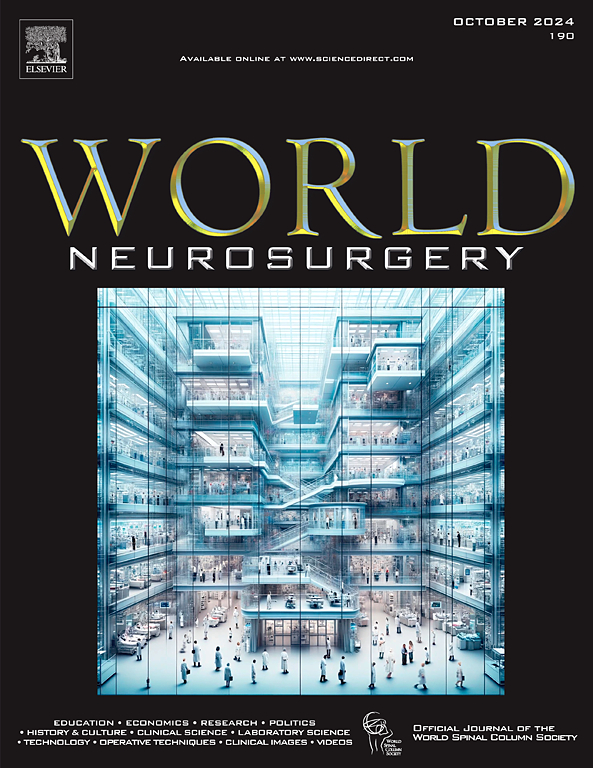The Spectrum of Vascular Injuries Secondary to Traumatic Brain Injury: A Single-Center Study Based on Digital Subtraction Angiography
IF 1.9
4区 医学
Q3 CLINICAL NEUROLOGY
引用次数: 0
Abstract
Background
To profile the spectrum of traumatic neurovascular injuries associated with traumatic brain injury (TBI) and their outcomes over ten years in a single central academic hospital.
Methods
Retrospective review of the TBI database to identify patients who underwent digital subtraction angiography (DSA) for suspected underlying intracranial and extracranial vascular injuries managed between January 2012 and December 2022. Medical records were analyzed for demographics, computed tomography (CT) angiography and DSA findings, and neurosurgical intervention.
Results
A total of 143 patients (median age 28 years) were included in the study. The majority of patients were male (89.5%). DSA confirmed vascular injuries in 76 (53.1%) patients. Injured blood vessels include internal carotid artery (22.4%), middle cerebral artery (14.0%), middle meningeal artery (3.5%), and others. DSA was negative in 67 (46.9%) of the TBI patients. Mechanisms of penetrating injury include knives, machetes, and screwdrivers. Closed injuries were commonly due to motor vehicle accidents (11.2%) and falls from a height (5.6%). The most common type of vascular injury is pseudoaneurysm 40 (33.1%). Dissection with vessel cut-off, and arteriovenous fistulas accounted for 17%, whilst traumatic carotid cavernous fistulas were seen in 15.4%. Most patients (60.1%) had Glasgow Coma Scale 15 at discharge.
Conclusions
The incidence of confirmed traumatic vascular injuries is high in DSA patients with suspected vascular injuries on CT/CT angiography after penetrating head and neck trauma. Vascular injury remains one of the major consequences of penetrating TBI, with associated morbidity and mortality. However, most patients in our series recover well with minimal perioperative and postoperative complications.
创伤性脑损伤继发血管损伤谱:基于数字减影血管造影的单中心研究。
目的/背景:分析一家中央学术医院近十年来创伤性脑损伤(TBI)相关的创伤性神经血管损伤及其预后。方法:回顾性审查TBI数据库,以确定2012年1月至2022年12月期间因疑似潜在颅内和颅外血管损伤而接受数字减影血管造影治疗的患者。分析医疗记录的人口统计学、CTA和DSA结果以及神经外科干预。结果:共纳入143例患者(中位年龄28岁)。患者以男性居多(89.5%)。DSA证实血管损伤76例(53.1%)。受损血管包括颈内动脉(22.4%)、大脑中动脉(14.0%)、脑膜中动脉(3.5%)等。67例(46.9%)TBI患者DSA阴性。穿透伤的机制包括刀、砍刀和螺丝刀。闭合性伤害最常见的是机动车事故(11.2%)和高空坠落(5.6%)。最常见的血管损伤类型是假性动脉瘤40(33.1%)。夹层伴血管切断,动静脉瘘占17%,外伤性颈动脉海绵状瘘(CCF)占15.4%。大多数患者(60.1%)出院时GCS为15。结论:穿透性头颈部外伤后CT/CTA显示疑似血管损伤的DSA患者确诊外伤性血管损伤的发生率较高。血管损伤仍然是穿透性脑外伤的主要后果之一,具有相关的发病率和死亡率。然而,在我们的研究中,大多数患者恢复良好,围手术期和术后并发症很少。
本文章由计算机程序翻译,如有差异,请以英文原文为准。
求助全文
约1分钟内获得全文
求助全文
来源期刊

World neurosurgery
CLINICAL NEUROLOGY-SURGERY
CiteScore
3.90
自引率
15.00%
发文量
1765
审稿时长
47 days
期刊介绍:
World Neurosurgery has an open access mirror journal World Neurosurgery: X, sharing the same aims and scope, editorial team, submission system and rigorous peer review.
The journal''s mission is to:
-To provide a first-class international forum and a 2-way conduit for dialogue that is relevant to neurosurgeons and providers who care for neurosurgery patients. The categories of the exchanged information include clinical and basic science, as well as global information that provide social, political, educational, economic, cultural or societal insights and knowledge that are of significance and relevance to worldwide neurosurgery patient care.
-To act as a primary intellectual catalyst for the stimulation of creativity, the creation of new knowledge, and the enhancement of quality neurosurgical care worldwide.
-To provide a forum for communication that enriches the lives of all neurosurgeons and their colleagues; and, in so doing, enriches the lives of their patients.
Topics to be addressed in World Neurosurgery include: EDUCATION, ECONOMICS, RESEARCH, POLITICS, HISTORY, CULTURE, CLINICAL SCIENCE, LABORATORY SCIENCE, TECHNOLOGY, OPERATIVE TECHNIQUES, CLINICAL IMAGES, VIDEOS
 求助内容:
求助内容: 应助结果提醒方式:
应助结果提醒方式:


